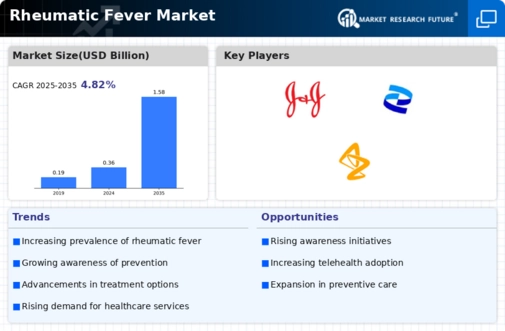Rheumatic Fever Size
Rheumatic Fever Market Growth Projections and Opportunities
The Rheumatic Fever Market faces a crucial role in responding to the disease that comes from untreated or inadequately treated streptococcal infections primarily affecting children and adolescents. It is an inflammatory response disorder leading to involvement of several body parts especially the heart, joints, skin and brain. Both prevention and management of rheumatic fever are important in the market due to its long-term health consequences such as rheumatic heart disease. This involves early administration of antibiotics including penicillin for treatment of streptococcal infection.
Pharmaceutical interventions also occupy significant space in the Rheumatic Fever Market which highlights the importance of antibiotics in fighting streptococcus infections beneath. The prevention of these infections becoming rheumatic fever greatly relies on immediate treatment with effective antibiotics. Moreover, non-steroidal anti-inflammatory drugs (NSAIDs) are given for its remedial functions and minimizing inflammation among affected people. In addition, it seeks timely and appropriate pharmaceutical interventions with a view towards preventing recurrences of RF episodes as well as mitigating associated health risks.
Rheumatic heart disease – a grave complication resulting from recurring attacks – lays emphasis on continuous cardiac care within this market environment. Consequently, monitoring and managing cardiac symptoms like valvular damage are central part of treatment strategy. Some cases may involve surgical procedures such as valve repairs or changes when they are complicated further. Therefore, this requires cardiology experts who work together with other healthcare providers like rheumatologists so that comprehensive care can be availed for people having it.
From a geographical perspective, Rheumatic Fever Market reaches out to areas having high incidences of streptococcal infections but limited access to healthcare services. While it has become less prevalent in developed countries, there remain high rates of rheumatic fever in certain regions within Africa Asia Pacific and Oceania groupings; hence, these disparities have been addressed by improving healthcare infrastructure; creating awareness and making essential drugs available in areas constrained by resources.
Nevertheless, the Rheumatic Fever Market is faced with several challenges including a disease that involves multiple organs and systems. The long-term effects on individuals, majorly regarding heart health require continuous monitoring and care. Additionally, ensuring access to healthcare services and medications pose as a hindrance within the market particularly in areas where there are scarce resources.
For this reason, going forward the Rheumatic Fever Market is expected to continue preventing its occurrence, early diagnosing as well as managing it comprehensively. It also seeks for further research on pathogenesis of RF known better and explore possible treatment enhancement options. In this regard, the industry has shown commitment towards addressing such social determinants of health like education and provision of medical facilities hence reducing global burden of RF including all its attendant complications.







Leave a Comment